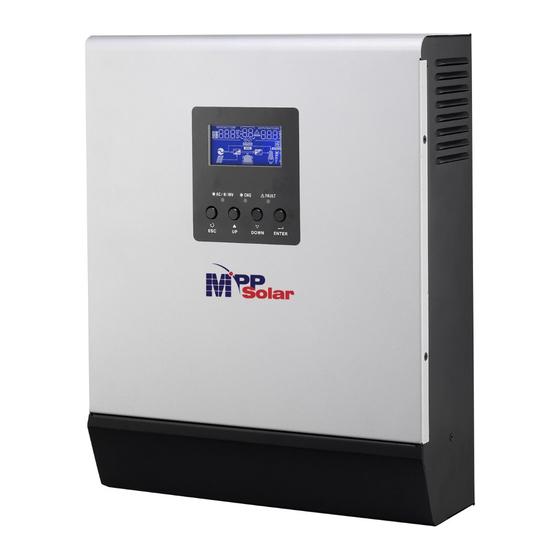Advertisement
PIP-HS/MS Series Parallel Installation Guide
1. Introduction
This inverter can be used in parallel
1. Parallel operation in single phase with up to 6 units. The supported maximum output power is
24KW/30KVA.
2. Maximum six units work together to support three-phase equipment. Four units support one phase
maximum. The supported maximum output power is 24KW/30KVA and one phase can be up to
16KW/20KVA.
NOTE: If this unit is bundled with share current cable and parallel cable, this inverter is default supported
parallel operation. You may skip section 3. If not, please purchase parallel kit and install this unit by following
instruction from professional technical personnel in local dealer.
2. Package Contents
In parallel kit, you will find the following items in the package:
Parallel board
3. Parallel board installation
This installation steps are only applied to 4K/5K models.
Step 1: Remove wire cover by unscrewing all screws.
Step 2: Remove communication board by unscrewing two screws as below chart.
with two different operation
Parallel communication cable
modes.
Current sharing cable
1
Advertisement
Table of Contents

Subscribe to Our Youtube Channel
Summary of Contents for MPP Solar PIP-HS Series
- Page 1 PIP-HS/MS Series Parallel Installation Guide 1. Introduction This inverter can be used in parallel with two different operation modes. 1. Parallel operation in single phase with up to 6 units. The supported maximum output power is 24KW/30KVA. 2. Maximum six units work together to support three-phase equipment. Four units support one phase maximum.
- Page 2 Step 3: Remove two screws as below chart and remove 2-pin and 14-pin cables. Take out the board under the communication board. Step 4: Remove two screws as below chart to take out cover of parallel communication. Step 5: Install new parallel board with 2 screws tightly. Step 6: Re-connect 2-pin and 14-pin to original position.
-
Page 3: Mounting The Unit
Step 7: Put communication board back to the unit. Step 8: Put wire cover back to the unit. Now the inverter is providing parallel operation function. 4. Mounting the Unit When installing multiple units, please follow below chart. NOTE: For proper air circulation to dissipate heat, allow a clearance of approx. 20 cm to the side and approx. 50 cm above and below the unit. -
Page 4: Recommended Battery Capacity
Recommended AC input and output cable size for each inverter: Model AWG no. Torque 4KVA 10 AWG 1.4~1.6Nm 5KVA 8 AWG 1.4~1.6Nm You need to connect the cables of each inverter together. Take the battery cables for example: You need to use a connector or bus-bar as a joint to connect the battery cables together, and then connect to the battery terminal. - Page 5 5-1. Parallel Operation in Single phase Two inverters in parallel: Power Connection Load Communication Connection Three inverters in parallel: Power Connection Load...
- Page 6 Communication Connection Four inverters in parallel: Power Connection Load Communication Connection...
- Page 7 Five inverters in parallel: Power Connection Load Communication Connection Six inverters in parallel: Power Connection Load Communication Connection...
-
Page 8: Power Connection
5-2. Support 3-phase equipment Two inverters in each phase: Power Connection Load Communication Connection Four inverters in one phase and one inverter for the other two phases: Power Connection Load Note: It’s up to customer’s demand to pick 4 inverters on any phase. P1: L1-phase, P2: L2-phase, P3: L3-phase. - Page 9 Communication Connection Three inverters in one phase, two inverters in second phase and one inverter for the third phase: Power Connection Load Communication Connection...
- Page 10 Three inverters in one phase and only one inverter for the remaining two phases: Power Connection Load Communication Connection Two inverters in two phases and only one inverter for the remaining phase: Power Connection Load...
- Page 11 Communication Connection Two inverters in one phase and only one inverter for the remaining phases: Power Connection Load Communication Connection...
- Page 12 One inverter in each phase: Power Connection Load Communication Connection WARNING: Do not connect the current sharing cable between the inverters which are in different phases. Otherwise, it may damage the inverters. 6. PV Connection Please refer to user manual of single unit for PV Connection. CAUTION: Each inverter should connect to PV modules separately.
- Page 13 7. LCD Setting and Display Setting Program: Program Description Selectable option Single: When the units are used in parallel with single phase, please select “PAL” in program It is required to have at least 3 inverters or Parallel: maximum 6 inverters to support three-phase equipment.
- Page 14 Fault code display: Fault Code Fault Event Icon on Power feedback protection Firmware version inconsistent Current sharing fault CAN fault Host loss Synchronization loss Battery voltage detected different AC input voltage and frequency detected different AC output current unbalance AC output mode setting is different 8.
- Page 15 Step 4: Switch on all AC breakers of Line wires in AC input. It’s better to have all inverters connect to utility at the same time. If not, it will display fault 82 in following-order inverters. However, these inverters will automatically restart.
-
Page 16: Troubleshooting
9. Trouble shooting Situation Fault Solution Fault Event Description Code Restart the inverter. Check if L/N cables are not connected reversely in all inverters. For parallel system in single phase, make sure the sharing are Current feedback into connected in all inverters. the inverter is For supporting three-phase system, make sure the sharing cables are detected.
















Need help?
Do you have a question about the PIP-HS Series and is the answer not in the manual?
Questions and answers